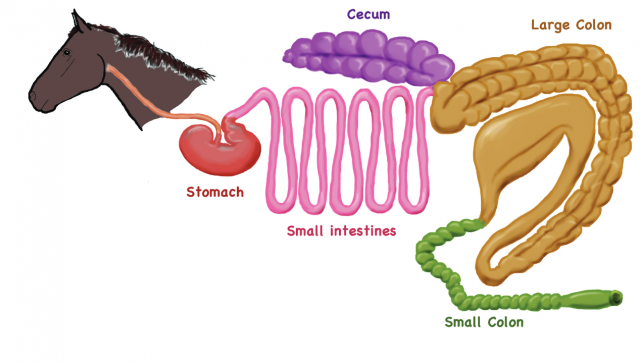Tract Facts: how much do you know about your horse’s guts?
The horse is a herbivore with a relatively small stomach and extensive intestinal tract divided into two parts, small and large. The figures below refer to an average 450-500 kg adult horse.
The total intestinal volume is about 230 Liters, a little more than an oil drum. Transit time, the time taken by food to pass through the entire length of the gut, is around 30 hours, less in small lighter horses and ponies, more in large breeds like draft horses.
Most of that time is spent in the large intestine, about 24 hours, with only a couple of hours in the stomach. The relative capacities and transit times for the different parts are shown below.
Stomach
7% (15 Litres)
2 Hours
Small Intestine
30% (70 Litres)
4 Hours
Large Intestine
63% (145 litres)
24 Hours
Fluids are added to the ingested food by glands associated with the gut. Firstly saliva – around 4 litres saliva is secreted for every kilo of hay ingested for example, but that amount varies with the type and dry matter content of the feed being consumed.
That kilo of hay would require 3,000 to 3,500 chews before it is swallowed in 80 boluses or portions, over 40 to 55 minutes. For concentrates or cereal grain, the numbers fall to 10 to 20 minutes per kilo with only 800 to 1,200 chews.
Saliva contains buffers to counter stomach acidity so the link between stomach ulcers and high grain, low forage diets is no coincidence. Daily saliva production totals a surprising 40 – 50 litres or enough to fill the petrol tank on a Honda Civic.

The stomach is relatively small and never fills completely under normal conditions but constantly empties as food is eaten. When a meal is complete the sphincter muscle closes tightly, shutting the stomach off from the oesophagus which is why horses cannot vomit.
Passage through the small intestine is quite rapid, despite its length of around 20 meters, and the digesta spends only 3-4 hours there. More fluids are added here including 5 litres of bile per day coming directly from the liver (horses have no gall bladder to store bile) and pancreatic juice, 7 litres daily, rich in protein digesting enzymes.
Some of the protein is digested here along with 70% to 95% of the sugars and starch. If starch intake exceeds 200g/ 100kg Bodyweight in a single meal, then part of the starch may escape the enzyme digestion in the small intestine and spill over into the large bowel causing trouble. Around 80% of fats and oils are digested in the small intestine which also accounts for most of the mineral absorption, except for Phosphorous, absorbed mainly in the colon.

Schematic of the horse’s digestive tract.
Image courtesy of nwdistrict.ifas.ufl.edu
The large intestine is essentially a fermentation vat, digesting what remains after the enzymes have done their work higher up the tract. These remnants include fiber, mainly cellulose from plant cell walls as well as some left -over protein starch and sugars. It is always full and houses an active microbial population turning those food residues into useful nutrients.
Each gram of hind gut contents contains from 5 to 7 billion bacteria, fungi, and protozoa. That’s 5 – 7,000,000,000 microbes per gram of dry material – and the large bowel contains 180 to 220 litres of contents, say 100,000 grams dry, so the microbe numbers are truly astronomical. When they die, they too are digested adding to the nutrient profile available for absorption. The most dominant families of bacteria have been identified but the precise identity of the bulk of these gut bugs remains a mystery for now.
We do know that these microbes digest fiber to produce energy in the form of volatile fatty acids, acetate, propionate, and butyrate, which are absorbed to meet between 30% and 70% of the horse’s total energy needs.
This digestive process generates waste heat as a by- product. A high fiber diet can therefore help maintain body heat during winter. The large intestine is like an onboard food factory. Its microflora can synthesize all the B group vitamins so, for horses at maintenance anyway, additional supplementation of the B group vitamins is unnecessary.
The hind gut also contains a large amount of water which acts as a reservoir, constantly exchanging its water content and electrolytes with the plasma and thereby regulating hydration. Around 40% of total water intake is excreted in the faeces, the balance being absorbed into the body before excretion in the urine, sweat and breath.
The microbiome of the hind gut is also producing hormones and neuro- transmitters, some of which are absorbed and impact on the body of the horse in ways yet poorly understood. The gut wall houses an extensive plexus of nerves which control its movement and receives input for transmission to the brain. And much of the body’s immune system is also found in the gut, sampling the materials coming in from the outside world and preparing defenses against invading pathogens. Truly, there’s a lot going on down there!
So, the digestive tract has some remarkable capabilities and by processing large amounts of relatively low- quality forage feeds it can extract all the nutrients the horse requires to thrive. Like other herbivores a lot of the heavy lifting is done by micro-organisms which in return benefit from a nice warm moist home to live in. This mutually beneficial commensal arrangement has evolved over long spans of time and works almost perfectly, until humans enter the picture and start feeding horses – but that’s another story!
